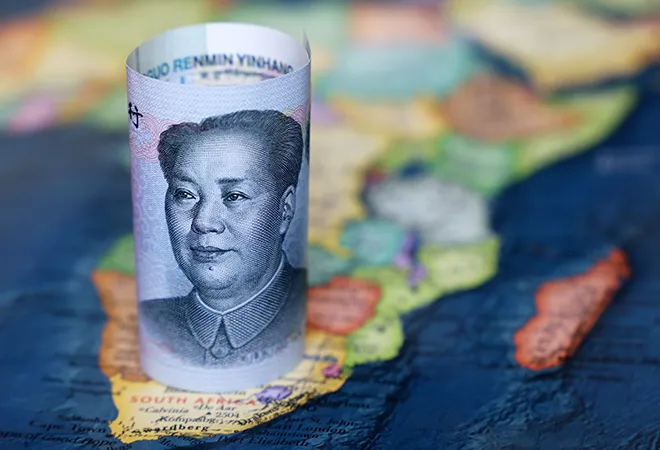 This is the 106th article in the series
This is the 106th article in the series The China Chronicles.
Read the articles here.
Before the ‘Africa Rising’ narrative gained currency, Africa’s debt crisis was one of the main subjects of development economics. In the 1980s, most African countries were in an unsustainable debt situation. According to economists Joshua Greene and Mohsin Khan, Africa’s total external debt rose from
US$ 8 billion in 1970 to US$ 174 billion at the end of 1987. As a proportion of exports of goods and services, Africa’s debt had increased from
73% in 1970 to 322% in 1987. By the mid-1990s, the international community felt the need for a coordinated approach to Africa’s debt problems and the International Monetary Fund (IMF) and the World Bank launched the Highly Indebted Poor Countries (HIPC) initiative to reduce the external public debt of poor countries. Africa’s debt burden was a major obstacle to economic development and poverty reduction.
On the back of rising commodity prices and China’s growing demand for commodities, most African countries experienced a turnaround from the early 2000s. This was the beginning of the ‘Africa Rising’ narrative. While western scholars and media were always sceptical of China’s growing footprint in Africa, it was difficult to ignore the impact of Chinese trade, investment, and financial flows on African economies. China emerged as the largest market, source, investor, builder, and donor for Africa. In one of its reports, the
World Bank also acknowledged the massive development opportunity that Chinese infrastructure finance offered to African countries. Chinese infrastructure in Africa was largely financed by loans from the Chinese EXIM Bank or the China Development Bank, often known as ‘infrastructure for resources’ loans because they were tied to resources exports. Countries like the Democratic Republic of Congo and Angola, which were rebuilding after a long civil war, welcomed Chinese finance because of their inability to raise resources for reconstruction from western financial institutions. Chinese loans helped finance railways, airports, roads, bridges, energy infrastructure, football stadia, hospitals, presidential mansions etc. in most African countries. China has also swarmed Africa under its Belt and Road Initiative (BRI). So far,
49 countries in Africa have signed MOUs with the Chinese government.
Chinese infrastructure in Africa was largely financed by loans from the Chinese EXIM Bank or the China Development Bank, often known as ‘infrastructure for resources’ loans because they were tied to resources exports.
After over a decade of unprecedented growth of Chinese finance, Africans are increasingly concerned over rising debt levels. Chinese external lending to African countries swelled but there was very little data on the actual loan amount and the terms on which such loans were extended. As a result, there is little scholarship on Chinese overseas lending. According to the China Africa Research Initiative’s database, which tracks China’s loan commitments, the Chinese government, banks, and contractors signed loan commitments worth
US$ 148 billion with African governments and their state-owned enterprises. Angola is the top recipient of Chinese loans, with
US$ 43 billion worth of loan commitments signed over 18 years. China is a leading bilateral lender in 32 African countries and has surpassed the World Bank as the top lender to the continent. Researchers like
Horn, Reinhart, and Trebesch assert that a substantial portion of China’s overseas lending is not reported and the problem of ‘hidden’ Chinese debt is particularly severe in a handful of neighbouring Asian countries and resource-rich African countries. This kind of opacity poses immense threats to African countries, which typically have weak institutions and poor governance structures.
China is being accused of providing unsustainable loans for uneconomical infrastructure projects in Africa to trap them in debt. According to analysts like Christoph Trebesch, African governments would remain indebted to China for decades and a series of defaults will occur in the future. Africans are also less enthusiastic about engaging with China today. Unlike in the past, African governments are more sceptical of Chinese money, and some are even renegotiating the terms of past agreements. For instance, the Tanzanian President, John Magafuli, has severely criticised his predecessor for accepting China’s unfavourable terms and cancelled the US$ 10 billion loan to construct a port at Mbegani Creek in Bagamayo. Many activists in Kenya, Zambia, Tanzania, and Nigeria are questioning the terms of Chinese loans and asking for a disclosure of the terms of credit. Angola, once the poster child of China’s ‘oil for infrastructure’ loans, is now facing an unsustainable external debt. The fall in oil prices has further exacerbated Angola’s vulnerabilities. Estimates suggest that Angola owes over US$ 20 billion to China and the country recently renegotiated its loans with China but as is the usual Chinese practice, details of the renegotiation have not been made public.
Unlike in the past, African governments are more sceptical of Chinese money, and some are even renegotiating the terms of past agreements.
Although some academics like Deborah Brautigam have argued that the problems associated with Chinese lending in Africa are exaggerated and it may not be difficult for African countries to gain debt relief from China, it is clear that China’s lending practices are unfavourable for most African countries. The process of lending is not transparent. As a result, Chinese loans escape public scrutiny. In many instances, even the exact loan amount is not known. Given the poor negotiating capabilities of most African governments, many African countries are now finding themselves locked in long-term loans with unfavourable terms. Some of the projects financed by Chinese loans have also failed to generate adequate returns.
China-Africa relations are at the crossroads. Until recently China was regarded as a friendly country which was willing to share its development experience with African countries and aid Africa’s economic transformation through infrastructure development. However, now, most African governments have second thoughts about Chinese loans. As observed above, many African nations are heavily indebted to China and their debt burden has the potential to completely derail their development trajectories and push the continent into more severe poverty. Most African countries were severely affected by the fall in commodity prices in 2014 but the COVID-19 pandemic-induced recession has pushed it towards its first recession in 25 years. The World Bank estimates a
-3.3 percent growth in Sub-Saharan Africa. Will this be the end of China-Africa bonhomie or will China provide massive debt relief to Africa? Under the G20 Debt Service Suspension Initiative, China has suspended principal repayments and interest payments for 40 Sub-Saharan African countries from 1 May 2020 to December 2020. Countries like Angola, which have borrowed extensively from the China Development Bank on commercial terms, have not gained much from this and are negotiating with China bilaterally. African countries need larger and longer-term debt relief from China to survive the socio-economic consequences of the pandemic.
Many African nations are heavily indebted to China and their debt burden has the potential to completely derail their development trajectories and push the continent into more severe poverty.
While Africa is staring at another debt crisis and the consequent development challenges, China is at an advantageous position. It has the potential to leverage its power over indebted African nations. But by doing so, it runs the risk of further damaging its global profile at a time when the country is facing criticism for its failure to report the COVID-19 pandemic and its military attack on India in the middle of a pandemic. Many countries are also slowly trying to diversify their supply chains to reduce their dependence on China. At this juncture, would China allow further deterioration of its global image by creating another African debt crisis or will it waive off or restructure its loans to Africa? Given that Chinese loans to Africa pose less of a threat to China’s own economic health and keeping in mind the immense human costs of the earlier episode of the African debt crisis, the latter seems more likely.
The views expressed above belong to the author(s). ORF research and analyses now available on Telegram! Click here to access our curated content — blogs, longforms and interviews.



 This is the 106th article in the series The China Chronicles.
Read the articles
This is the 106th article in the series The China Chronicles.
Read the articles  PREV
PREV


